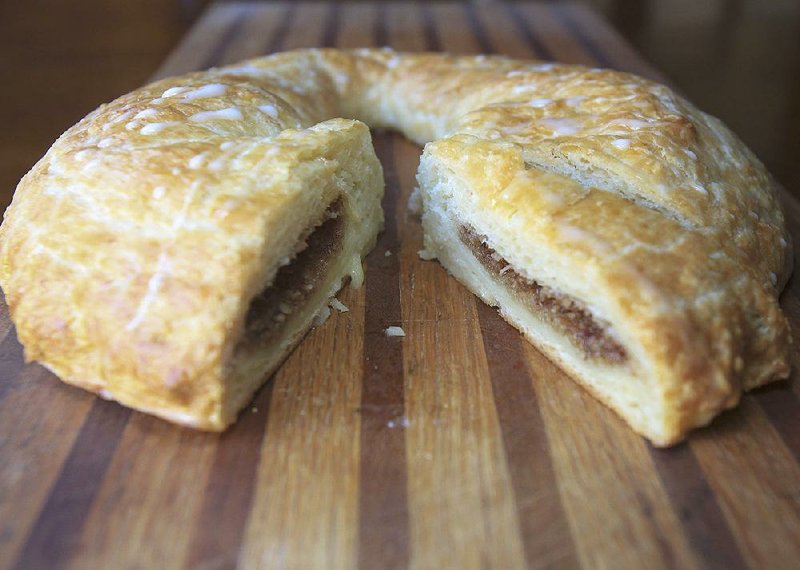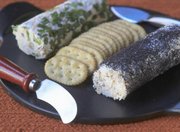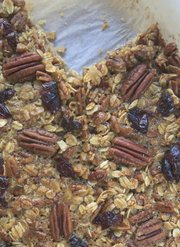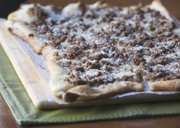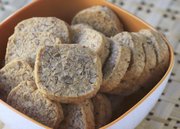A pecan tree stands just on the other side of the fence on the southwest side of the house. Its tall canopy of branches is ample enough to shade two houses. In the summer squirrels scurry from bough to branch plucking the nuts from their clusters and tearing into the green fleshy coating, cracking the shell and gobbling up the meat inside. The remains are fervently discarded, hitting the roof in thuds and crashes.
During pecan season, one does not sleep late in a second-story bedroom under such a tree. And one never walks barefoot in the side-yards between nearby houses.
In the fall, the clusters that are not pillaged by the squirrels eventually ripen, their green husks turning to brown and opening, releasing the meaty nuts that will fall to the ground, either on their own or with a nudge from a pole.
It's backbreaking work, stooping and gathering the nuts by hand, but there is something quite satisfying about eating a pecan that grew in your own (or next-door neighbor's) yard.
A smart gatherer with productive trees might invest in a pecan picker-upper -- a wire basket with a handle that picks up the nuts (and the occasional rock) as it is rolled across the ground.
For the rest of us, farmers markets and grocery stores brim with bins of nuts in their shells or, for a price, bags of pristine, shelled pecan halves just waiting to be eaten.
The pecan is currently the only major nut tree native to North America, according to the United States Department of Agriculture Forest Service.
The black walnut, though indeed native, is not considered a "major" crop, with just 25 million pounds harvested per year, compared with more than 300 million pounds of pecans. The American chestnut was all but wiped out by fungus in the early 20th century. The majority of U.S.-grown chestnuts are from Chinese-American hybrids. Acorns, produced by oak trees, are generally not considered people food.
Pecans were a seasonal staple of the American Indian diet, and the name comes from the Algonquin word "pakan" or "paccan."
Pecans are most commonly associated with pie and pralines, but the native nut adds flavor and crunch to a variety of foods, sweet and savory.
Basic Buttered Salted Pecans
3 cups pecan halves
1 tablespoon unsalted butter
1 teaspoon kosher salt
Spread the pecans in a single layer in a large skillet (work in batches if necessary). Place over medium heat. Cook, stirring frequently and watching carefully for scorching, for 8 to 10 minutes or until the pecans are very fragrant and just starting to darken, but do not have burned spots.
Pour hot pecans into a large, heat-safe bowl. Add the butter and stir until butter is melted and pecans are lightly coated. Sprinkle with salt, stirring to coat. Serve immediately or cool and store in an airtight container for several days.
Makes about 3 cups.
Recipe adapted from Pecans: A Savor The South Cookbook by Kathleen Purvis
Cheddar-Pecan Shortbread
1/2 pound finely shredded sharp cheddar cheese
1/2 cup butter, softened
2 cups finely chopped pecans
3/4 cup all-purpose flour
1/4 cup white whole-wheat flour
1/2 teaspoon kosher salt
1/4 teaspoon ground black pepper
1/4 teaspoon ground red pepper (cayenne)
Using an electric mixer, beat the cheese, butter and nuts until well combined.
Whisk together the flours, salt, black pepper and cayenne. Add flour mixture to cheese mixture and mix thoroughly until dough comes together when pressed. Form the dough into 2 logs, wrap each log in plastic wrap or waxed paper and refrigerate at least 30 minutes and up to 3 days; or freeze for up to 1 month (thaw dough before baking).
When ready to bake, heat oven to 350 degrees. Line a baking sheet with parchment. Cut the logs into 1/4-inch-thick slices, place the slices on the baking sheet, and bake for 20 minutes, or until golden at the edges. Remove the shortbread slices and cool them on a wire rack. Store in an airtight container for 3 to 5 days.
Makes about 3 dozen.
The kringle is the official state pastry of Wisconsin, and its origins are Danish, but its pecan filling is decidedly American. Traditional kringles take days to make, but this streamlined version from America's Test Kitchen can be ready in time to serve the same day (if you start early enough).
Kringle
Filling:
1 cup pecans, toasted
3/4 cup packed light brown sugar
1/4 teaspoon ground cinnamon
1/8 teaspoon salt
4 tablespoons butter, cut into 1/2 inch pieces and chilled
Dough:
4 cups all-purpose flour
1 cup butter, cut into 1/2-inch pieces and chilled
4 tablespoons vegetable shortening, cut into 1/2-inch pieces and chilled
2 tablespoons confectioners' sugar
2 1/4 teaspoons instant yeast
3/4 teaspoon salt
2 cups sour cream
1 to 2 tablespoons ice water, or as needed
1 egg, lightly beaten
Glaze:
1 cup confectioners' sugar
2 tablespoons whole milk OR half-and-half
1/2 teaspoon vanilla extract
For the filling: In a food processor, pulse the pecans, sugar, cinnamon and salt until pecans are coarsely ground. Add butter and pulse until mixture resembles coarse meal. Transfer to a bowl.
For the dough: Add the flour, butter, shortening, sugar, yeast and salt to the now-empty food processor bowl (if your processor holds less than 11 cups, you will need to work the dough in two batches). Pulse until mixture resembles coarse meal. Transfer to a large bowl and stir in sour cream until a dough forms. If dough appears shaggy and dry, stir in up to 2 tablespoons of the ice water. Turn dough out on to a lightly floured surface and divide in half. Pat each piece into a 7-by-3-inch rectangle. Wrap each rectangle in plastic wrap. Refrigerate dough 30 minutes, then freeze until firm, about 15 minutes.
Line 2 rimmed baking sheets with parchment paper. On a lightly floured surface, roll one piece of the dough into a 28-by-5-inch rectangle, about 1/4-inch thick, with the wide side facing you. Leaving 1/2-inch border around the bottom and side edges, spread half of the nut filling over half of the rectangle. Brush uncovered edge of dough with water, fold dough over filling and pinch seams closed. Shape folded dough into a crescent shape or an oval ring, by tucking one end inside the other and pinching to seal.
Repeat with remaining dough and filling.
Transfer crescents or ovals to the prepared baking sheets; cover with plastic wrap and refrigerate 4 to 12 hours.
Heat oven to 350 degrees. Remove plastic from dough, brush with beaten egg and bake on middle and lower oven racks 40 to 50 minutes, or until golden brown, rotating sheets halfway through baking. Transfer baked kringles to wire racks and cool for 30 minutes.
For the glaze: Whisk together the sugar, milk and vanilla. Drizzle over cooled kringles. Let glaze set for 10 minutes. Serve warm or at room temperature. Kringles can be stored at room temperature for up to 2 days.
Recipe adapted from Cook's Country Eats Local: 150 Regional Recipes You Should Be Making no Matter Where You Live from America's Test Kitchen
The traditional nut coating on cheese balls can make serving them cumbersome. This version puts the nuts on the inside, adding texture and flavor throughout.
Ranch Chicken Cheese Logs
2 (8-ounce) packages neufchatel or regular cream cheese, softened
1 (10-ounce) can white meat chicken, drained
1 (1-ounce) package ranch dressing mix
1/2 cup sour cream OR plain Greek yogurt
4 ounces finely shredded cheddar cheese
1 cup chopped pecans
Chopped green onion tops or minced fresh chives, for coating
Poppy seeds, for coating
Crackers and crudites, for serving
In a medium bowl, combine the cream cheese, chicken, ranch dressing mix, sour cream, cheddar and nuts and mix well. Divide mixture in half and shape into two logs. Wrap in plastic wrap and chill for 30 minutes. Unwrap logs; roll one log in chopped green onions to coat. Roll the second log in poppy seeds. Rewrap in plastic or wax paper and chill 2 hours to overnight. Serve with crackers and/or assorted crudites.
Makes 8 to 10 servings.
These bars remind us of a cross between pecan pie and granola in bar cookie form.
Honey Oat Pecan Bars
2 cups all-purpose flour
1 1/4 cups firmly packed brown sugar, divided use
3/4 teaspoon salt, divided use
1 cup cold butter, cut into small cubes PLUS 1/4 cup butter, melted and cooled slightly, divided use
1/4 cup honey
4 eggs
2 teaspoons vanilla extract
1 1/2 cups coarsely chopped pecans PLUS 1/2 cup pecans halves, divided use
1 cup rolled oats
1/2 cup dried cranberries, optional
Heat oven to 350 degrees. Grease or line a 9-by-13-inch baking pan with parchment paper.
Combine the flour, 1/2 cup brown sugar and 1/2 teaspoon salt in a mixing bowl. Add the cold butter and mix with a pastry blender or fork until combined. The dough will be crumbly, but it should hold together when pressed.
Press mixture evenly in the bottom of the prepared pan. Bake 15 minutes. Set aside to cool slightly.
In a large bowl, combine the remaining brown sugar, melted butter, honey, eggs, vanilla and remaining salt and mix well. Stir in chopped pecans and oats. Spread mixture over crust. Sprinkle with cranberries, if using, and pecan halves. Return pan to oven and bake 25 to 30 minutes more or until filling is set. Cool in pan for 15 minutes before cutting into bars.
Makes 24 bars.
Recipe adapted from Quick-Shop-&-Prep 5 Ingredient Baking by Jennifer McHenry
This flavor-packed pesto gets its a fiery kick from fresh chiles. Serve it on a cheese platter, with roasted meats or as a flatbread topping.
Spicy Pecan Pesto
2 cups pecan pieces, lightly toasted
4 cloves garlic
2 fresh jalapenos, stemmed and seeded, if desired
2 teaspoons whole black peppercorns, crushed
1/2 teaspoon kosher salt
1/3 cup walnut or sunflower oil
Splash balsamic vinegar
In a food processor, lightly grind the nuts. Add the garlic, jalapenos, peppercorns, salt and oil and process to as fine a paste as possible. Add the vinegar and puree again. Use immediately or refrigerate for up 2 days. Bring to room temperature before serving.
Makes about 2 cups.
Recipe adapted from Bold: A Cookbook of Big Flavors by Susanna Hoffman and Victoria Wise
Food on 11/04/2015
